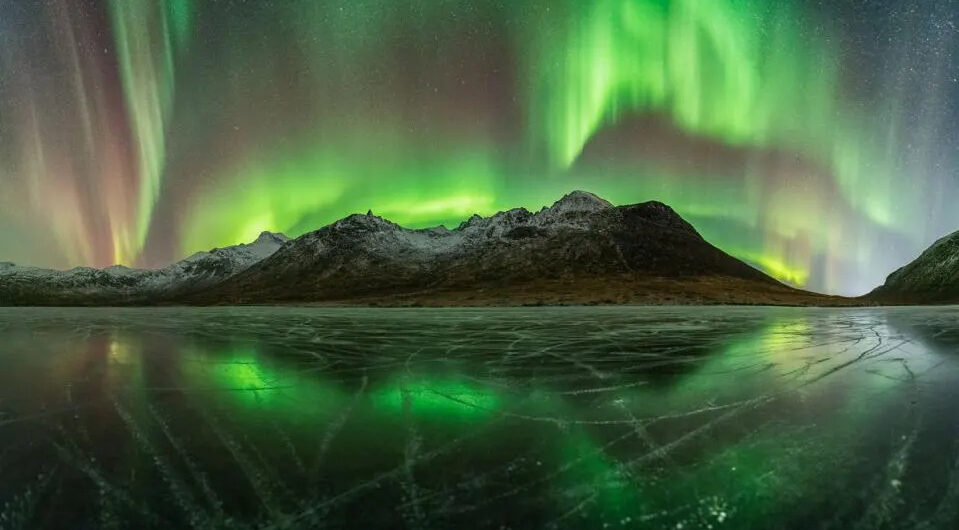Can you really see Northern lights (Aurora Borealis) in Ladakh as many photos being shared on social media have made a buzz ever since IIA Bengaluru shared a timelapse video captured by Hanle Observatory of Ladakh where red clouds can be seen in the skies of Ladakh.
While most photos are old, mostly from Norway and Iceland, the IIA Bengaluru stated: “This is a time-lapse of the sky taken by a 360 deg camera from #Hanle on 22/23 April night. You can see the aurora lights due to an intense geomagnetic storm that hit the Earth. It is extremely rare to see aurora at such a low latitude! At 11:42 PM on 21 Apr the Sun launched a coronal mass ejection towards the Earth. This CME (speed of 500-600 km/s) was associated with an M1 class solar flare. The CME arrived at Earth late on April 23 at 10 PM.
It further stated that This geoeffective CME led to an excellent night for auroral activity. The aurora came to lower-than-usual latitudes overnight leading to rare sightings from Europe, China & Ladakh in India. Such a severe geomagnetic storm last occurred in 2015. “For predictions of this storm as well as space weather forecasts for other solar events, check out @cessi_iiserkol Centre for Excellence in Space Sciences India at @iiserkolhttp://cessi.in
#Aurora from #Ladakh!
This is a time-lapse of the sky taken by a 360 deg camera at from #Hanle on 22/23 April night. You can see the aurora lights due to an intense geomagnetic storm that hit the Earth. It is extremely rare to see aurora at such a low latitude! @dstindia (1/n) pic.twitter.com/gGbrw86vsb— IIAstrophysics (@IIABengaluru) April 29, 2023
According to news portal The Quint, while the first three images show the Northern Lights in Norway, the fourth one is from Iceland. While aurora-like lights were seen in Ladakh in the night between 22 and 23 April, all these photos predate the event. It further stated that none of the photos being circulated on social media belong to northern lights in Ladakh.
Outlook India has written an article on northern lights in ladakh:
If you’re an avid stargazer, add Ladakh to your bucket list. This region, situated in the Western Himalayas at an elevation of 4,500 meters (14,764 ft), is a stargazer’s paradise. It is home to the Hanle Observatory, which is one of the highest located sites for optical, infrared, and gamma-ray telescopes in the world. In fact, it’s currently the tenth highest optical telescope in the world.
But it’s not just about stargazing here. Recently, Ladakh also offered an experience of a lifetime—the Northern Lights! Also known as the aurora borealis, this spectacular light show is a result of a solar storm. Energized particles from the sun slam into Earth’s upper atmosphere at speeds of up to 45 million mph (72 million kph), resulting in dancing waves of light.
Typically, the Northern Lights are only visible in countries like Norway, Finland, Iceland, and Greenland. But in a rare event, this event was also visible in Ladakh.
The Indian Astronomical Observatory in Hanle, Ladakh, recently shared a mesmerizing time-lapse of auroras visiting Ladakh on April 22 and 23. The lights painted the skies amazing shades of green and yellow, sprinkled with specks of orange and white. It was an extremely rare event, and one that many people will never have the opportunity to see in their lifetime.
Why did it happen?
On Friday, April 21, an explosion on the Sun hurled a coronal mass ejection (CME) towards our planet. This CME was associated with a medium-sized M1 class solar flare. Space weather experts expected this flare to trigger a G-1 or G-2 class (minor to moderate) geomagnetic storm on Earth. But what arrived was an unprecedented G-4 class severe geomagnetic storm late on April 23, around 10 PM IST.
The geo-effective CME caused the Northern Lights to descend to never-seen-before mid-to-low latitudes over the US, in brightly-lit European cities, and even over China and India. Reports suggest such a dramatic dip hasn’t been seen since 2015! These geomagnetic or solar storms are significant disturbances in the Earth’s magnetosphere that occur when billions of tons of plasma from solar CMEs embedded with its magnetic field arrive at Earth.

Comments